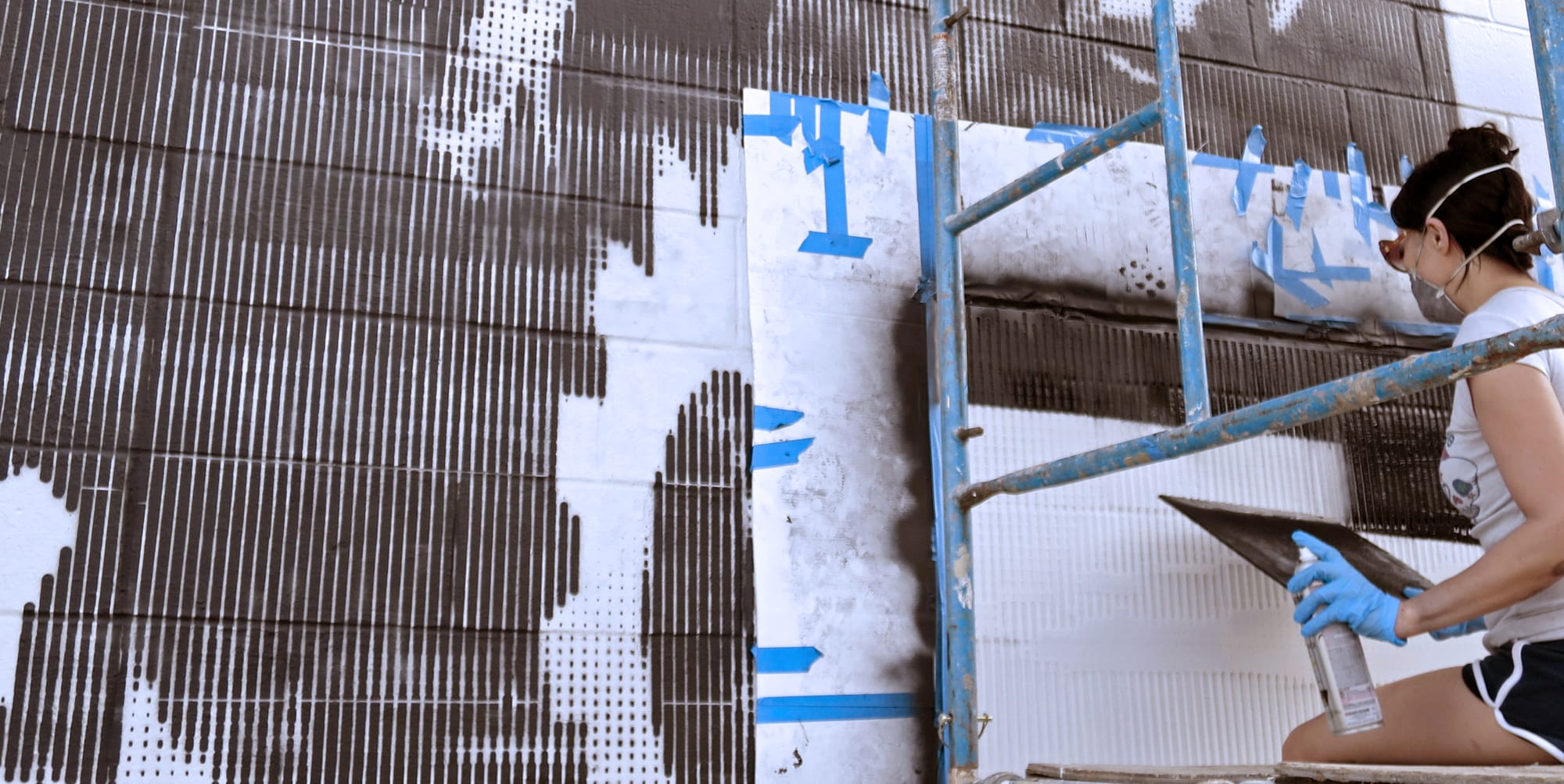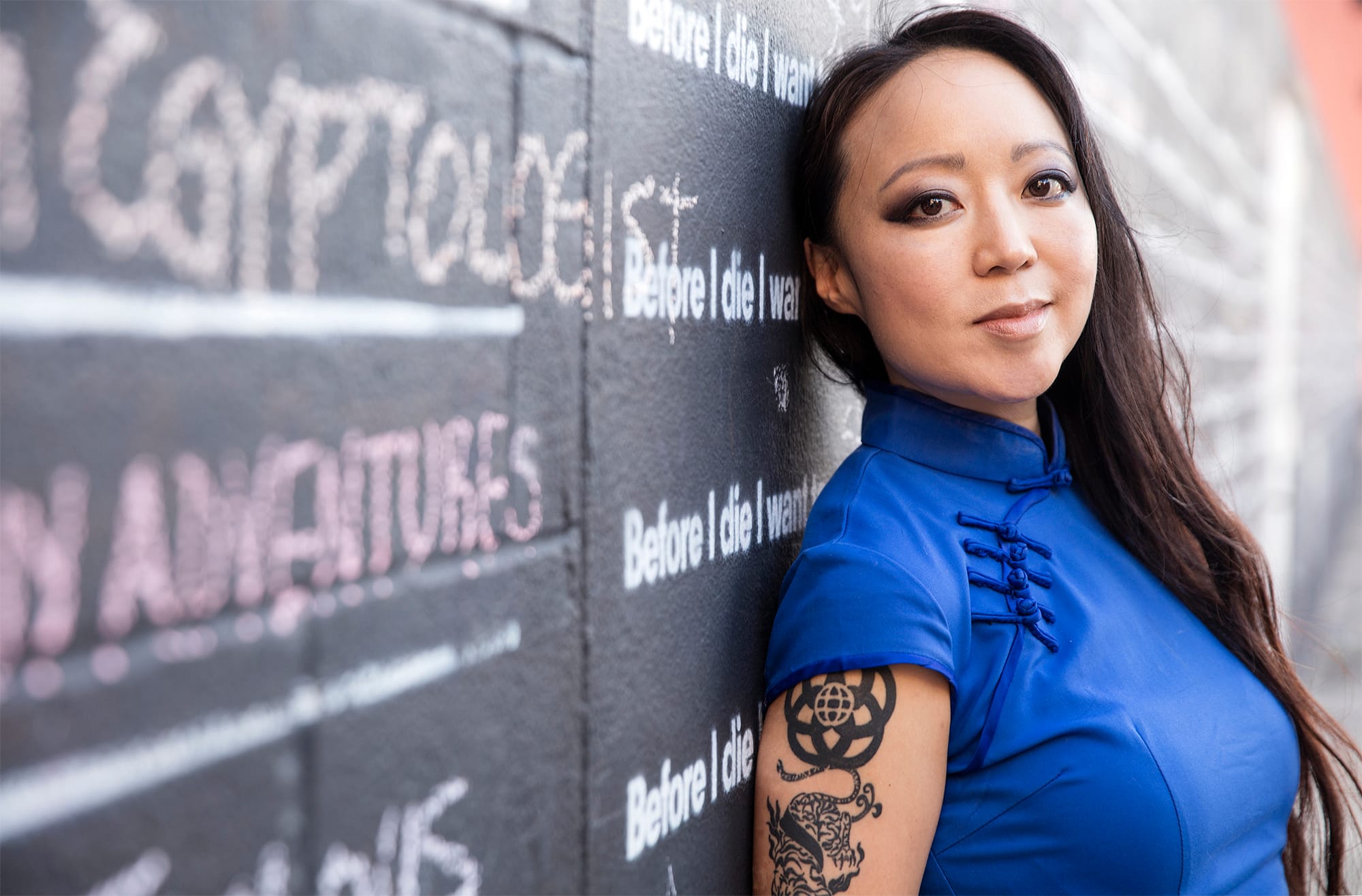Press

“Before I Die is merely one of the most creative community projects ever.”
—The Atlantic
“Memorial art works are notoriously difficult to pull off. Yet Candy Chang and James A. Reeves, two New York artists who have created similar installations in the past, hit just the right tone with After the End, a participatory work in the Historic Chapel at Green-Wood Cemetery... It provides a place for anyone suffering loss or battered by contemporary life to mourn, meditate and perhaps heal a little.”
—The New York Times
“Candy Chang’s work at the intersection of public art, community engagement, and urban design touches on every aspect of art’s role in society and contributes to meaningful placemaking in our communities.”
—Public Art Review
"In a world increasingly marked by isolation and division, artist Candy Chang offers a powerful counterpoint: we can still design spaces—physical, emotional, and communal - that foster connection, reflection, and belonging. Best known for her global Before I Die project, Chang has transformed walls, museums, neighborhoods, and even casinos into places of shared vulnerability, creativity, and hope."
—Unlikely Collaborators

“Do you embrace your doubts and nervous thoughts? Or tuck them away? For artist Candy Chang, these emotions are material. Her public art works are internationally renowned for their vulnerability and interactivity… From public displays of anonymously submitted secrets to collecting a community's dreams and aspirations for their built environment to encouraging others to cry in public, Chang's emotionally driven projects prove we may have more in common with our neighbors than we think.”
—Forbes
“Candy Chang's art serves as a wake-up call in our fast-paced digital age. Armed with little more than chalk, labels or post-it notes, she transforms nondescript urban spaces into compelling works that inspire the often device-obsessed masses to engage with each other, and the world around them.”
—Ad Age
“Candy Chang’s public art pieces more than please the eye. They demand dialogue and encourage conversations. ”
—AP News

“We love the work of artist, designer and TED Fellow Candy Chang... The notion of turning neglected space into an active invitation to engage with your community and get to know your neighbors is a wonderful embodiment of enlightened urbanism. What’s more, it’s a reminder that not all meaningful social platforms are accessed through a screen.”
—Brain Pickings
“[Chang's] art installations offer a vehicle for understanding, one that allows people to be vulnerable and share their beliefs, their joys, and their struggles... In doing so, she’s helping progress the universe’s gradual arc toward collective acceptance. Because we all experience emotions like fear, anger, regret, sorrow, and joy; and because we all, at some point, have a brush with issues like anxiety, addiction, depression, and self-destruction. And when we do, we all deserve compassion.”
—UPROXX
“Good urban design doesn’t just help people engage with their cities; according to artist and designer Candy Chang, it also helps people engage with each other… Chang creates public spaces that spark conversation and reflect a sense of community identity—often using little more than chalk, stickers, and some creativity.”
—The Atlantic

“Artist and social activist Candy Chang uses unlikely canvases—blighted buildings, empty storefronts, abandoned houses—to get people talking... Through a series of large-scale projects that combine installation art with social activism, Chang has encouraged people to engage with public spaces to let their voices be heard.”
—O, The Oprah Magazine
“Candy Chang has different cultures in her DNA but just one obsession: intervening in public space. For her, it’s like setting up a hybrid board game designed for mass participation in the heart of the city. Thanks to this artistic modus vivendi in which art flirts with activism, Chang’s large-scale participatory installations both blur the boundaries between public and private and give passers-by the opportunity to spontaneously interact with and ask questions about her works. Ultimately, her installations provide the public with the means to reclaim the space around and within them.”
—Onassis Cultural Centre
“We are way into Candy Chang's work because it makes urban systems and possibilities visible while bringing a much-needed sense of narrative and personality to the all-too-often dry world of wayfinding, data visualization and public information exchange. In the process, she articulates an important field of action for designers of all disciplines.”
—Urban Omnibus

“Candy Chang’s ambitious projects answer the question ‘Can art change the world?’ with a unanimous ‘Yes.’ With the help of neighbors and dreamers everywhere, she’s making the world a better place, one street corner at a time.”
—We R Classic
“Candy Chang’s sense of humility, curiosity, empowerment and open-minded perspective on life touches every project she’s shared... Using what she describes as 'low-barrier tools,' Chang’s work embodies a pure direct magic. The chalkboard and primary colors used in Before I Die are a welcome reminder of limitless childhood imagination. Many of her art projects have the comfortable feel of teaching materials that wipe away fear around sharing your unique voice and offer a safe space for being creative in public. ”
—Crixeo
“It’s hard to know where to begin with Candy Chang… We love how she has opened up discourse around public space by providing people with easy and innovative ways to have a say about how their urban environment should be developed. Whether it is with post-it notes or a piece of chalk, Chang has proven that you don’t need big budgets to have a big impact.”
—Wooster Collective / USA Network

“Candy Chang isn't like any artist we've ever come across. Her uniqueness lies in her ability to blend contemporary aesthetics, public art, lightness and deep community engagement all at the same time. ”
—Kindle Project
“They're the stuff of everyday life from people of all walks of life... Young or old, rich or poor, the Before I Die wall does make you think as you walk by.”
—NBC News
“Art as a forum for localized collective experience is invariably the driver of Chang’s work... Looking for Love Again became a slowly unfolding town hall convening, a perfect crystallization of what I interpret as the colliding themes that have fueled her remarkably poignant, accessible, and affecting brand of art: mental health and the desire to be heard, the dynamics of public space, and ultimately, living with ourselves and each other.”
—Pelican Bomb
- The TODAY Show. "Sheinelle Jones trains for NYC Marathon with Mural Miles," August 23, 2023.
- The Nightly News and International Artist Candy Chang, MSU International Studies and Programs, March 30, 2023.
- The Long Now Foundation. "What If The Best Times Are Still To Come?" by Johanna Hoffman, October 10, 2022.
- Public Art Journal. "Twenty Years of Public Art in the United States: Relationships, Transformations, and Digital Interventions," by Jessica Fiala and Shi Qian, 2022.
- New Constellations audio interviews. "Candy Chang: Kinship with Everything." February 2022.
- The New York Times. "Three Art Gallery Shows to See Right Now" by Martha Schwendener. October 22, 2021.
- PIX11 News, New York City. "Green-Wood Cemetery Launches Art Installation" by Stacy-Ann Gooden. October 6, 2021.
- Spectrum News NY 1. "Brooklyn installation turns private loss into public art," by Rebecca Greenberg, November 13, 2021.
- Brooklyn Magazine. "Green-Wood Cemetery Wants You to Describe Your Loss: A new exhibit at the cemetery called 'After the End' prompts visitors to write down their personal experiences 'after 18 months of grief,' by Mags Chmielarczyk, September 16, 2021.
- Brooklyn Downtown Star. "Participatory installation comes to Green-Wood," by Nicholas Loud, September 16, 2021.
- Health Magazine. "Public Display of Anticipation" by Rich Sands. Special Edition: Managing Stress, June 2021, p.94.
- Financial Times. "Rap, Royalty, and the Secrets of a Well-lived Life," by Enuma Okoro, Apr 16, 2021.
- Do:Better Interview: "Five Questions, One-Word Answers," Apr 2021.
- Design, Create, Thrill: The Power of Graphic Design to Spark Emotions by Sara Caldas. p 56-57, 62. Barcelona, Spain: Hoaki Books, 2020.
- TIME Magazine. "Public Display of Anticipation" by Rich Sands. Special Edition: The Science of Stress, Sep 2019, p.94.
- Forward Magazine. "Light the Barricades: Three Sites for Meditating on Resentments, Judgments, and Doubts," by Forecast. Issue #1, 2019.
- KTLA, Los Angeles. "Artists Candy Chang and James Reeves on Their ‘Light the Barricades’ Public Art Installations Debut," September 6, 2019.
- ABC News. "Public Art in LA Shines a Light on Emotions" by Adrienne Alpert, September 12, 2019.
- TED and Marriott animated video: "TED Fellow Candy Chang: Travel Showed Me the Power of Home," May 15, 2019
- Mississippi Today. "'Before I Die' Global Arts Project Inspires Mississippians to Turn their Hopes and Dreams into Words," by Sherry Lucas, May 3, 2019.
- The Atlantic. "Your Flaws Are Probably More Attractive Than You Think They Are: 'Beautiful messes' have a certain allure" by Emily Esfahani Smith, January 9, 2019.
- Women Amplified: 20 Years of Insights from Trailblazing Leaders from the Stage of the Texas Conference for Women edited by Lisa Bennett. p 26-27. Austin, Texas: Greenleaf Book Group Press, 2019.
- Public Art Review. "Transforming our Future with Public Art," Issue 57, 2018.
- Public Art Journal. "Art Intervenes in Community: Case Studies of American Community" by Lu Wei, No.4, 2018.
- Tricycle Magazine. "Spotlight On: Candy Chang & James A. Reeves" by Wendy Joan Biddlecombe, Summer 2018.
- Women's Health Magazine. "Five Stunning Pieces of Art That Prove Death Doesn't Have To Be Sad" by Meirav Devash, February 8, 2018.
- Forbes. "This Artist Turns Anxiety and Fear into Public Art," by Jane Claire Hervey, January 30, 2018.
- UPROXX. "How A Global Art Project Connects People Through Their Insecurities," by Jessica Toomer, August 25, 2017.
- Bungalower. "Beyonce of Urbanism, Candy Chang, Coming to Winter Park," by Brendan O'Connor, July 12, 2017.
- Crixeo. "Candy Chang's Interactive Street Art Experiments," by Christa McIntyre, Feb 2017.
- Forecast Public Art. "Interaction and Introspection," Fall/Winter 2016.
- AP News. "In Philadelphia, spin the giant dial, find life guidance," by Natalie Pompilio, July 7, 2016.
- Public Art Review Magazine. "Dialing for Wisdom: Candy Chang's Latest Project The Atlas of Tomorrow," by Amelia Foster, Issue 55, Fall/Winter 2016, p.72-75.
- LEAP Dialogues: Career Pathways in Design for Social Innovation, edited by Mariana Amatullo, Bryan Boyer, Liz Danzico, Andrew Shea, Designmatters, 2016.
- NBC News. "New Orleans Artist Candy Chang Introduces Interactive Spinning Mural to Philly" by Natalie Pompilio, July 7, 2016
- Mental Floss. "Role Model: Candy Chang" by Jen Doll, Volume 15, Issue 3, May/June 2016.
- Pelican Bomb. “Storytelling in the Streets: An Interview with Candy Chang” by Nick Stillman, November 5, 2015.
- DMI: Review. “Candy Chang: Social Design in Arts and Letters,” Summer 2014, Vol. 25, Issue 2, p. 40-41.
- Print Magazine. “Women Who Design” by Sabrina Shuttles, February 2014, p. 40-47.
- CBS News. “Before I Die Art Project Goes Global” by Magalie Laguerre-Wilkinson, December 28, 2013.
- AP News. “Public Art Project Elicits the Profound, Profane” by Carolyn Thompson, December 4, 2013.
- CNN. “‘Before I Die’ Walls Turn Dreams Into Words” by Emanuella Grinberg, December 2, 2013.
- Brain Pickings. “Before I Die: A Global Ethnography of Anonymous Aspirations in Chalk and Public Space” by Maria Popova, November 2013.
- BMW Guggenheim Lab. “100 Urban Trends: Public Space” by Christine McLaren, Sep 2013.
- Origin Magazine. “Top Creatives,” March/April 2013.
- Public Art Review Magazine. “Conversations with Five Artists Who Think Deeply About How Public Art Can Shape Our Experience of Place” by Joseph Hart, Issue 47, November 2012.
- TED Blog, "Six Art Installations by Candy Chang that Make the Viewer Part of the Piece," by Kate Torgovnick May, September 2012.
- CNN. “Assignment: I Wish This Was…”, August 2012.
- Bloomberg. “Confessions From Sin City” by Emily Badger, August 2012.
- The Walker Art Center. ”Fill-in-the-Blank: Candy Chang’s Urban Interventions and Open-Ended Questions” by Paul Schmelzer, April 2012.
- The Exeter Bulletin. "Candy Chang '95" by Susannah Clark, Spring 2012.
- NBC News with Brian Williams. “Hopes and Dreams Become Urban Art,” December 6 2011.
- O, The Oprah Magazine. "How Candy Chang’s Public Art Projects Are Changing Communities Everywhere” by Jessica Sivester, September 2011 issue, p60.
- Grist. ”The City Speaks – and Artist Candy Chang Finds Fresh Ways to Listen” by Greg Hanscom, December 2011.
- The Atlantic. “A Conversation with Candy Chang, Public Installation Artist and Designer” by Samantha Michaels, August 2011.
- Fast Company. “Looking for Love Again: Abandoned Buildings That Ask Cities For Renewal” by Morgan Clendaniel, June 2011.
- USA Network. “The Innovative Candy Chang” by Wooster Collective, May 2011.
- Juxtapoz Magazine. “An Interview with Candy Chang” by Helen Soteriou, April 2011
- La Tempestad Contemporary Arts Magazine. ”Candy Chang: Antes De Morir” by Gerardo Terán, Issue 77, April 2011.
- Design Observer. “The Interventionist’s Toolkit: Posters, Pamphlets and Guides” by Mimi Zeiger, March 2011.
- Wired Magazine. “TED 2011: What Do You Want To Do Before You Die?” by Olivia Solon, March 2011
- The Atlantic. "Designing Community: Candy Chang's 'Before I Die' Project" by Kaid Benfield, May 12, 2011.
- TYPO Magazine. “Disciplines Are as Wide as We Want Them to Be: An Interview with Candy Chang” by Linda Kudrnovská, Issue 42, Winter 2010, p 30-37.
